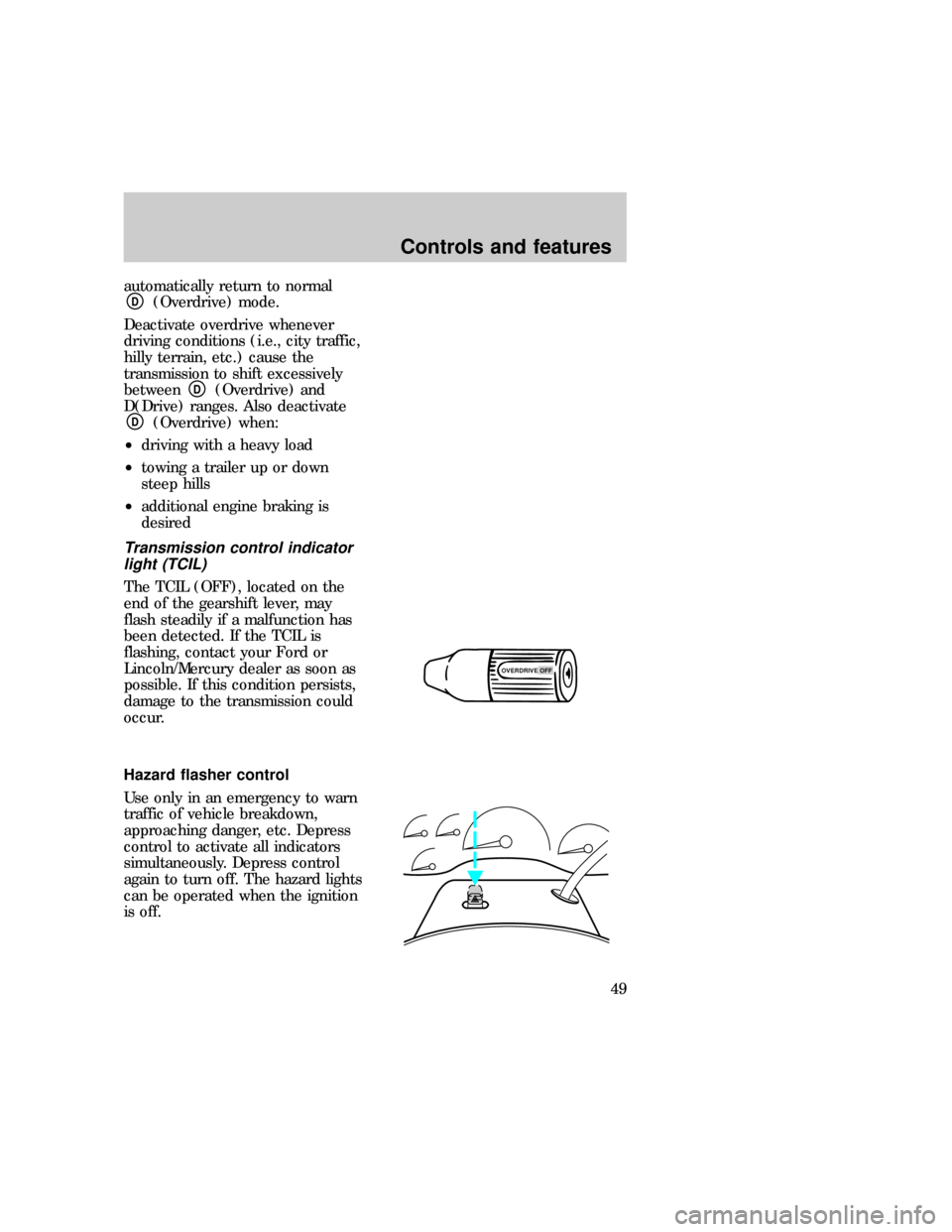Page 39 of 224
Positions of the ignition switch
1(Accessory)Ð allows electrical
accessories such as the audio
system and wiper/washer to
operate when the engine is not
running.
2(Lock)Ð locks the steering
wheel and automatic gearshift
lever.
3(Off)Ð shuts off the engine and
all accessories without locking the
steering wheel.
4(On)Ð tests the warning lights.
Key remains here when engine is
running.
5(Start)Ð cranks the engine.
Key returns to 4(On) when
released.
35
2
4
1
exd_ignition_positions
exd_speed_control_title
Controls and features
40
Page 48 of 224

automatically return to normalD(Overdrive) mode.
Deactivate overdrive whenever
driving conditions (i.e., city traffic,
hilly terrain, etc.) cause the
transmission to shift excessively
between
D(Overdrive) and
D(Drive) ranges. Also deactivate
D(Overdrive) when:
²driving with a heavy load
²towing a trailer up or down
steep hills
²additional engine braking is
desired
Transmission control indicator
light (TCIL)
The TCIL (OFF), located on the
end of the gearshift lever, may
flash steadily if a malfunction has
been detected. If the TCIL is
flashing, contact your Ford or
Lincoln/Mercury dealer as soon as
possible. If this condition persists,
damage to the transmission could
occur.
Hazard flasher control
Use only in an emergency to warn
traffic of vehicle breakdown,
approaching danger, etc. Depress
control to activate all indicators
simultaneously. Depress control
again to turn off. The hazard lights
can be operated when the ignition
is off.
OVERDRIVE OFFexd_hazards
exd_tilt_steering
Controls and features
49
Page 66 of 224

ANTI-THEFT SYSTEM
Passive anti-theft system
Your ignition key has a unique
imbedded transponder which
engages engine electronics and
allows the vehicle to be started.
Without the use of your special
ignition key, the vehicle will not
start.
During each vehicle start, the
coded key is read by the anti-theft
system. If the key's ID code
matches the code in the anti-theft
system, the vehicle is enabled to
start.
Your vehicle is equipped with two
electronically coded keys.
Additional spare keys can be
purchased through your dealer or
selected retailers. Be sure to
purchase coded keys with the Ford
logo to ensure proper functionality.
If both supplied keys are lost or
stolen, the vehicle and any other
keys must be reinitialized by the
dealer.
A theft indicator in the instrument
cluster provides operating status of
the anti-theft system. For more
information on this indicator and
its function, refer toWarning and
indicator lightsin the
Instrumentationchapter.
Programming spare keys
Use one of the two electronically
coded keys supplied with your
vehicle to program additional keys:
THEFT
com_anti-theft_passive.01
exd_passive_anti_theft
exd_programming_key
Controls and features
67
Page 99 of 224
BEFORE STARTING YOUR
VEHICLE
Important safety precautions
A computer system controls the
engine's idle revolutions per
minute (RPM). When the engine
starts, the idle RPM runs faster to
warm the engine. If the engine idle
speed does not slow down
automatically, have the vehicle
checked. Do not allow the vehicle
to idle for more than ten minutes.
Extended idling at high
engine speeds can produce
very high temperatures in the
engine and exhaust system,
creating the risk of fire or other
damage.
Do not park, idle, or drive
your vehicle in dry grass
or other dry ground cover. The
emission system heats up the
engine compartment and exhaust
system, which can start a fire.
Do not start your vehicle
in a closed garage or in
other enclosed areas. Exhaust
fumes can be toxic. Always open
the garage door before you start
the engine. SeeGuarding
against exhaust fumesin this
chapter for more instructions.
exd_title_starting
com_important_precautions.05
Starting
100
Page 100 of 224
If you smell exhaust fumes
inside your vehicle, have
your dealer inspect your vehicle
immediately. Do not drive if you
smell exhaust fumes.
Preparing to start the vehicle
Engine starting is controlled by the
spark ignition system. This system
meets all Canadian
Interference-Causing Equipment
standard requirements regulating
the impulse electrical field strength
of radio noise.
When starting a fuel-injected
engine, avoid pressing the
accelerator before or during
starting. Only use the accelerator
when you have difficulty starting
the engine. For more information
on starting the vehicle, refer to
Starting the vehiclein this
chapter.
Before starting the vehicle:
1. Make sure all vehicle occupants
have buckled their safety belts. For
more information on safety belts
and their proper usage, refer to
theSeating and safety restraints
chapter.
exd_preparing_start
Starting
101
Page 102 of 224
Make sure the corresponding lights
illuminate briefly. If a light fails to
illuminate, have the vehicle
serviced.
²If the driver's safety belt icon is
fastened, the
light does not
illuminate.
STARTING YOUR VEHICLE
Starting the engine
1. Turn the key to 5 (Start)
without pressing the accelerator.
The key will return to 4 (On).
2. If the engine does not start
within five seconds, wait ten
seconds and try again.
3. If the engine does not start in
two attempts OR the temperature
3
1050
3070
4080
120
140
40
20
0
10090 60
8060100
20 km/h
0010
0000052
4
5
6 01LH
CH
EF
818
THEFT
RPMx1000LOW
RANGE
4x4 FUEL
RESET CHECK
ENGINEABS
DOOR
AJARLOW
FUEL3
1050
3070
4080
120
140
40
20
0
10090 60
8060100
20 km/h
0010
0000052
4
5
6 01LH
CH
EF
818
THEFT
RPMx1000ABS
BRAKELOW
FUEL!
3
2
1
5
4
exd_starting_title_2
com_starting_vehicle.01
Starting
103
Page 103 of 224
is below Ð12ÉC (10ÉF), depress
accelerator and start the engine
while holding the accelerator
down. Release accelerator when
engine starts.
4. After idling for a few seconds,
apply the brake and release the
parking brake.
Using the engine block heater
(if equipped)
An engine block heater warms the
engine coolant, which improves
starting, warms up the engine
faster and allows the
heater-defroster system to respond
quickly. They are strongly
recommended if you live in a
region where temperatures reach
Ð23ÉC (±10ÉF) or below.
For best results, plug the heater in
at least three hours before starting
the vehicle. Using the heater for
longer than three hours will not
harm the engine, so the heater can
be plugged in the night before
starting the vehicle.
To prevent electrical
shock, do not use your
heater with ungrounded
electrical systems or
two-pronged (cheater) adapters.
com_engine_heater.01
com_ventilation_info.01
Starting
104
Page 104 of 224
Important ventilating
information
If the engine is idling while the
vehicle is stopped in an open area
for long periods of time, open the
windows at least 2.5 cm (one
inch).
Adjust the heating or air
conditioning (if equipped) to bring
in fresh air.
Improve vehicle ventilation by
keeping all air inlet vents clear of
snow, leaves and other debris.
FLR
& DEF MAX
A/CFLOOR PANEL &
FLOOR
DEF OFF
PANEL
A/C
WARM COOL
LO
HI
com_guarding_exhaust.01
Starting
105